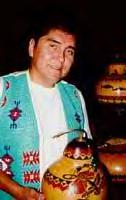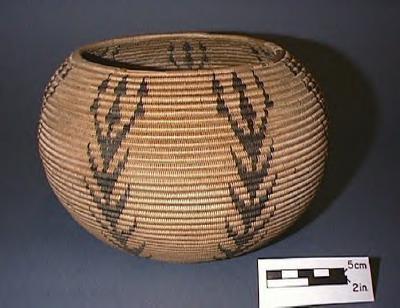|
 For years,
Juanita Snooks sat at a table in her small home in the foothills. She heaped a pile of wet willow branches on a
plastic cloth. These were branches gathered from tribal stream banks in Nevada. In her place, she began to weave. For years,
Juanita Snooks sat at a table in her small home in the foothills. She heaped a pile of wet willow branches on a
plastic cloth. These were branches gathered from tribal stream banks in Nevada. In her place, she began to weave.
She made baskets. Beautiful baskets of simple but intricate Native American designs. Designs that she learned from
her mother. Who learned from her mother. Baskets that are quite valuable now, though Juanita Snooks was never inspired
by money.
"She was a traditional Washoe," David Snooks says of his mother, who died six years ago. "She believed
in Washoe (spiritual) beliefs. She was honored for her basketry. And she enjoyed that honor. But to be singled
out was not her way of thinking."
Today, at the same table, David Snooks sits at his mother's place. He does not make baskets. Instead, he paints
gourds. His work, too, is intricate and simple. It is reminiscent of his mother's work. But it is an entirely new
generation of native craft.
"I start at the top with hand-strung beads," says Snooks of his approach. "And then I work down
the gourd with geometric patterns and animal designs. The gourd becomes what it is. My designs are respectful of
the elders. The gourds are done in the Washoe tradition. But they are completely original."
David Snooks is now sitting in a quiet room at the State Indian Museum. For many years, Snooks worked as a museum
interpreter here. "My duty was to answer all the questions from schoolchildren," says Snooks, laughing.
"I was supposed to know it all."
Snooks is 48 years old -- and knows a great deal. He is gentle-mannered and immensely soft-spoken. He has short
black hair, carved cheekbones, copper coloring. He is wearing jeans, a dress shirt, a beaded necklace given to
him by elder Vivian Hailstone, whose tribal jewelry is highly coveted.
Today, from 10 a.m. to 4:30 p.m., there will be an Arts and Crafts Fair at the State Indian Museum, 2618 K St.
Some of the noted Native American artists being exhibited include jewelers Josephine Peters and Diane Rosales,
potter Vicky Weatherford, doll maker Helen Kawelo and textilist Chris Ipena.
David Snooks' gourds will be on display, too. They range in size from egg-shaped vessels to gourds as big as pumpkins.
All bear his spare style and attention to detail. "I don't like to brag," he says painfully. "But
I have gained a little name for myself. There is pride in my product. The quality is there."

Peer closely at the gourds, beaded and buffed to a rich chestnut color, and perhaps you can see the delicately
woven spirit of Juanita Snooks.
David Snooks was raised in Pioneer, near Jackson. This is Miwok country. His Washoe ancestors hail from Lake Tahoe,
a place revered as a sacred site. His great-grandmother was named Lillian, his grandmother was Leta. His father,
Elmer Snooks, also a full-blooded Washoe, worked in a lumber mill.
David was the first in his family to attend college, earning a degree in sociology at CSUS. He has held various
jobs, from being a naturalist in the Grand Tetons, to an archaeological monitor in identifying and preserving Indian
burial sites in the path of development. Self-taught, he began painting gourds seriously about seven years ago.
"When I start a gourd," he says, "I adhere to the old basket maker's tradition. I only make one
gourd at a time. And I don't work if I'm sick. Otherwise, it is believed your illness will affect the work."
Though there is a history of gourd painting in western folk culture, it is not regarded as an "official"
Native American craft. In many respects, Snooks is blazing a new tradition in tribal handiwork.
"Some people call it an art," he says. "I prefer to call it gourd craft. I feel like my mother.
She used to say that making baskets was her life. It is the same with gourds. Even if I didn't sell them, I would
still make them. When I find a beautiful gourd, I can't wait until I can begin to work on it."
He holds up a bowl-shaped gourd. So polished it catches a faint sheen of his ancient image. "I am proud of
my gourds," he says. "I am proud of being Washoe."
Washoe
http://itcn.org/tribes/washoe/intro.html
Washoe Educational Project
http://www.unr.edu/nnap/WC/wc_main.htm
|
 For years,
Juanita Snooks sat at a table in her small home in the foothills. She heaped a pile of wet willow branches on a
plastic cloth. These were branches gathered from tribal stream banks in Nevada. In her place, she began to weave.
For years,
Juanita Snooks sat at a table in her small home in the foothills. She heaped a pile of wet willow branches on a
plastic cloth. These were branches gathered from tribal stream banks in Nevada. In her place, she began to weave.